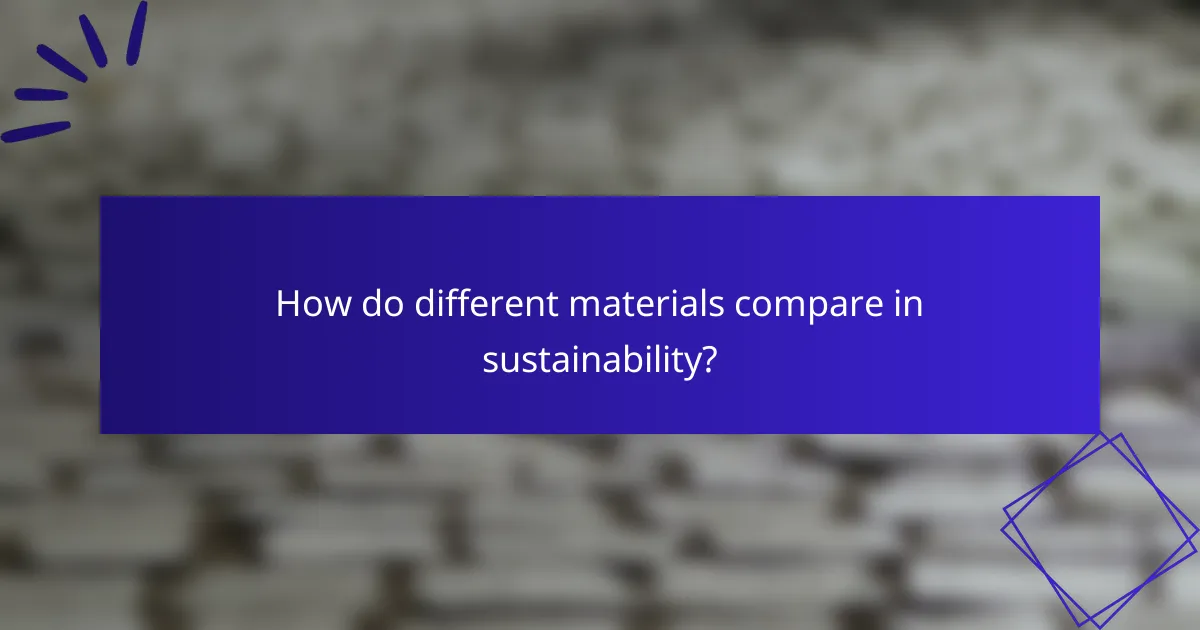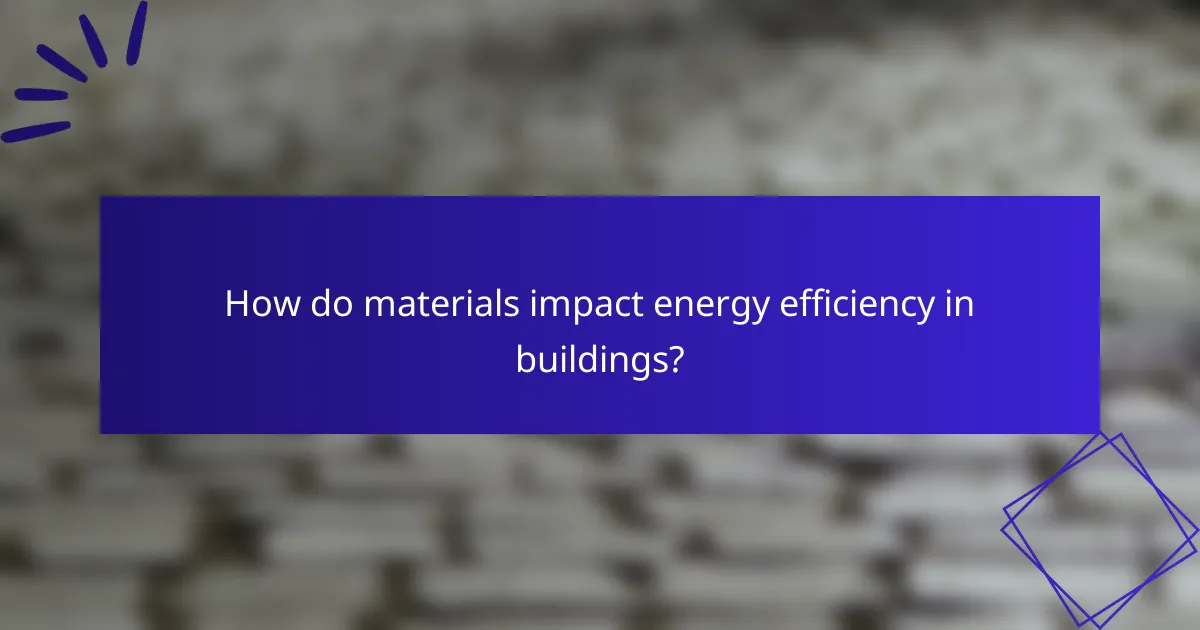Amazing materials play a crucial role in various applications, showcasing their versatility across industries. From concrete and steel in construction to advanced composites in technology, each material possesses unique properties that cater to specific needs. Additionally, considerations of sustainability and environmental impact further influence the choice of materials, highlighting the importance of recyclability and energy consumption in their production.

What are the most versatile materials for construction?
The most versatile materials for construction include concrete, steel, wood, glass, and composite materials. Each of these materials offers unique properties that make them suitable for a wide range of applications, from structural support to aesthetic finishes.
Concrete
Concrete is a composite material made from cement, water, and aggregates. Its strength, durability, and resistance to weather make it ideal for foundations, walls, and pavements.
When using concrete, consider factors such as curing time and mix design, as these can affect performance. For instance, high-strength concrete is often used in high-rise buildings, while standard concrete suffices for residential projects.
Steel
Steel is known for its high tensile strength and flexibility, making it a preferred choice for structural frameworks. It can withstand heavy loads and is often used in skyscrapers, bridges, and industrial buildings.
When selecting steel, consider the grade and treatment, as these influence corrosion resistance and load-bearing capacity. Common grades include structural steel (like ASTM A36) for construction and stainless steel for environments prone to rust.
Wood
Wood is a renewable resource that provides natural aesthetics and good insulation properties. It is commonly used in residential construction for framing, flooring, and cabinetry.
When working with wood, choose the right type based on moisture resistance and strength. For example, pressure-treated wood is ideal for outdoor applications, while hardwoods are often used for furniture and flooring.
Glass
Glass is valued for its transparency and ability to enhance natural light in buildings. It is used in windows, facades, and interior partitions.
Consider the type of glass, such as tempered or laminated, for safety and energy efficiency. Double-glazed units can significantly improve thermal performance, making them suitable for energy-efficient designs.
Composite materials
Composite materials combine two or more materials to achieve superior properties, such as lightweight strength and resistance to corrosion. They are increasingly used in construction for applications like cladding and flooring.
When choosing composite materials, evaluate their specific properties, such as fire resistance and environmental impact. For example, fiber-reinforced polymers are popular for their strength-to-weight ratio and durability in challenging environments.

How do different materials compare in sustainability?
Different materials vary significantly in sustainability based on their source, production processes, and end-of-life options. Key factors include recyclability, biodegradability, and the energy consumed during manufacturing.
Recycled materials
Recycled materials are those repurposed from waste products, reducing the need for virgin resources. Common examples include recycled plastics, metals, and paper, which can significantly lower environmental impact by conserving energy and reducing landfill waste.
When selecting recycled materials, check for certifications like the Recycling Symbol or the Global Recycled Standard. These can help ensure that the materials meet specific sustainability criteria and are genuinely recycled.
Biodegradable options
Biodegradable materials break down naturally over time, minimizing long-term environmental impact. Examples include certain bioplastics, paper products, and natural fibers, which can decompose in composting conditions.
To ensure effective biodegradation, consider the conditions required for breakdown, such as temperature and moisture. Look for certifications like ASTM D6400 or EN 13432, which indicate compliance with compostability standards.
Energy-efficient production
Energy-efficient production refers to manufacturing processes that consume less energy, reducing greenhouse gas emissions. Techniques include using renewable energy sources, optimizing machinery, and improving supply chain logistics.
When evaluating materials, consider those produced using renewable energy or those that have undergone lifecycle assessments to quantify energy use. Products labeled with energy efficiency certifications can guide consumers toward more sustainable choices.

What are the applications of advanced materials in technology?
Advanced materials are utilized in various technological applications, enhancing performance and efficiency across industries. Their unique properties enable innovations in electronics, aerospace, and robotics, among others.
Graphene in electronics
Graphene, a single layer of carbon atoms arranged in a two-dimensional lattice, is revolutionizing the electronics sector. Its exceptional electrical conductivity and mechanical strength make it ideal for applications in flexible displays, high-speed transistors, and energy storage devices.
For instance, graphene-based transistors can operate at higher frequencies than traditional silicon counterparts, potentially leading to faster and more efficient electronic devices. However, the production of high-quality graphene remains a challenge, often requiring advanced techniques that can be costly.
Carbon fiber in aerospace
Carbon fiber is widely used in the aerospace industry due to its high strength-to-weight ratio and resistance to corrosion. Aircraft components made from carbon fiber are significantly lighter than those made from traditional materials, which improves fuel efficiency and overall performance.
Common applications include wings, fuselage sections, and interior components. While carbon fiber parts can be more expensive to manufacture, the long-term savings in fuel costs and maintenance often justify the initial investment.
Smart materials in robotics
Smart materials, which can respond to environmental changes, are increasingly employed in robotics to enhance functionality and adaptability. These materials can change shape, stiffness, or other properties in response to stimuli such as temperature, light, or electric fields.
For example, shape memory alloys can return to a predetermined shape when heated, allowing for more versatile robotic designs. However, integrating smart materials into robotic systems requires careful consideration of their response times and durability to ensure reliable performance in dynamic environments.

What factors should be considered when selecting materials?
When selecting materials, key factors include cost-effectiveness, durability, and availability. These aspects significantly influence the overall performance and feasibility of a project, ensuring that the chosen materials meet both budgetary and functional requirements.
Cost-effectiveness
Cost-effectiveness refers to the balance between the price of materials and their performance. When evaluating materials, consider not only the initial purchase price but also long-term costs such as maintenance and replacement. For example, while a cheaper material may save money upfront, it could lead to higher costs over time due to frequent repairs.
To assess cost-effectiveness, create a comparison table that includes initial costs, expected lifespan, and maintenance expenses. This will help in making informed decisions that align with budget constraints.
Durability
Durability is the ability of a material to withstand wear, pressure, or damage over time. When selecting materials, consider their resistance to environmental factors such as moisture, temperature fluctuations, and chemical exposure. For instance, materials like stainless steel are known for their longevity in harsh conditions, while others may require regular replacement.
Evaluate durability by looking at industry standards and testing results. Materials that meet or exceed these standards are typically more reliable and can save costs in the long run due to reduced maintenance needs.
Availability
Availability refers to how easily materials can be sourced and supplied. When selecting materials, consider local suppliers and the potential for delays in procurement. Materials that are readily available locally can reduce lead times and transportation costs, making them more practical for immediate projects.
Check with local suppliers for stock levels and delivery timelines. Additionally, consider the potential impact of global supply chain issues on material availability, as this can affect project schedules and budgets significantly.

How do materials impact energy efficiency in buildings?
Materials significantly influence energy efficiency in buildings by affecting heat retention, insulation, and overall energy consumption. Choosing the right materials can lead to reduced energy costs and improved comfort levels within the structure.
Insulation properties
Insulation materials are crucial for minimizing heat transfer between the interior and exterior of a building. Effective insulation can reduce heating and cooling demands, leading to energy savings of around 20-30%. Common insulation materials include fiberglass, foam board, and cellulose, each with varying R-values that indicate their thermal resistance.
When selecting insulation, consider local climate conditions. In colder regions, higher R-values are essential, while milder climates may require less insulation. Proper installation is also vital; gaps or compression in insulation can significantly reduce its effectiveness.
Thermal mass
Thermal mass refers to a material’s ability to absorb, store, and release heat. Materials with high thermal mass, such as concrete or brick, can help regulate indoor temperatures by absorbing heat during the day and releasing it at night. This can lead to reduced reliance on heating and cooling systems.
In warmer climates, strategically using thermal mass can keep buildings cooler, while in colder areas, it can help retain warmth. However, it’s essential to balance thermal mass with insulation to avoid heat loss during colder months.
Reflectivity
Reflectivity, or albedo, is the ability of a material to reflect sunlight. High-reflectivity materials can help reduce heat absorption in buildings, leading to lower cooling costs, especially in hot climates. For example, reflective roofing materials can lower roof surface temperatures by several degrees.
When choosing materials, consider their reflectivity ratings, particularly for roofs and external walls. Light-colored or specially coated surfaces can enhance energy efficiency by minimizing heat gain, which is particularly beneficial in sunny regions.
